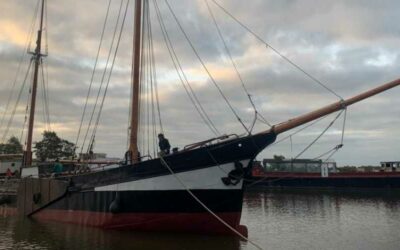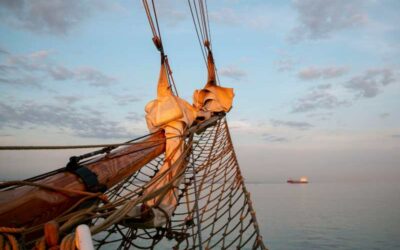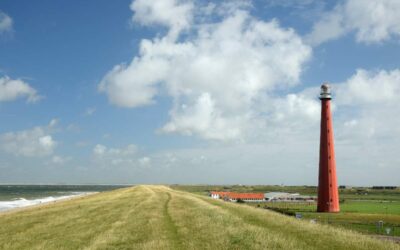Examining The US Fleet Of 1906
“In considering the various types of deep water vessels, it is found that each kind possesses certain advantages. A square rigged vessel can spread a lot of canvass in a fair wind and with the wind abeam or aft of the beam she can make good time, often outsailing a tramp steamer for days at a time. The square rigger is also a good heavy weather ship…. It requires a comparatively large crew to handle a square rigger. Further, a square rigger will not make good headway when sailing on the wind.
“About the only advantage possessed by a bark over a ship, assuming that in both cases the vessel is a 3-master, is that the bark can be handled by a smaller crew…. The barkentine possesses a decided advantage in the opinion of many seamen over a bark or a ship in that it is easily handled… [with] all the advantages of a schooner of working to windward with the added value of square sails for running free.
“The principal advantage of a fore-and-aft rigged vessel is that it is quite easy to handle in tacking ship…. She is in her safest position with her head near the wind…. The fact that a fore-and-aft rigged vessel can be handled by a small crew, however, has caused this rig to become popular.”
Felix Riesenberg, Standard Seamanship For The Merchant Service 1936.
At the beginning of the 20th century, the windjammer fleet was competing against steam and other mechanically propelled vessels, and needed to maximize the labor efficiency of their operations to remain competitive. In 1900, steam propulsion finally surpassed sail tonnage in the US Fleet, while this had occurred ten years prior in Europe. This is a similar position to the windjammers of today, which need to find high-value cargos and transport them economically with relatively small vessels. Making a comparison of the historical fleet around the turn of the 20th century should give a significant insight into the types of rigs favorable to these business conditions.
Examining The US Fleet Of 1906.
To gather information on the relative distribution of rigs in a given fleet, the entire sailing fleet recorded in the US Bureau of Navigation’s 1906 edition of the Annual List of Merchant Ships Of The United States was entered into a spreadsheet. Yachts and vessels under 10 Net Register Tons were excluded from the survey, which yielded 7,216 vessels. Crew requirements, Net Register Tonnage, and rig were collected from the Annual List, and Tons Per Sailor were calculated by simply dividing the Net Register Tonnage by the Crew listed. It should be noted that the crew was given exclusive of the captain, thus in some cases the Crew was given as “0”. This was increased by 1 for such instances to allow for calculations to continue in the spreadsheet. This generally effected vessels of under 20 NRT, with very few exceptions.
The results of this survey give us some insight into the US fleet of 1906, but primarily a lot of information about the efficiency of rigs in terms of Tons per Sailor. This concern with Tons per Sailor is a metric of crew efficiency, and as Labor Costs are one of the main expenses on a Windjammer, are important in making a vessel competitive.
There is also a delineation of reasonable tonnage ranges for each type of rig. Overall numbers show Schooners were by far the most prolific type of ship, and spanned the survey from the smallest to the largest of vessels. On average, the most efficient rig of the survey in terms of Tons per Sailor was the Ship rig, though this is balanced by it being in the largest Tonnage range of any vessel type.

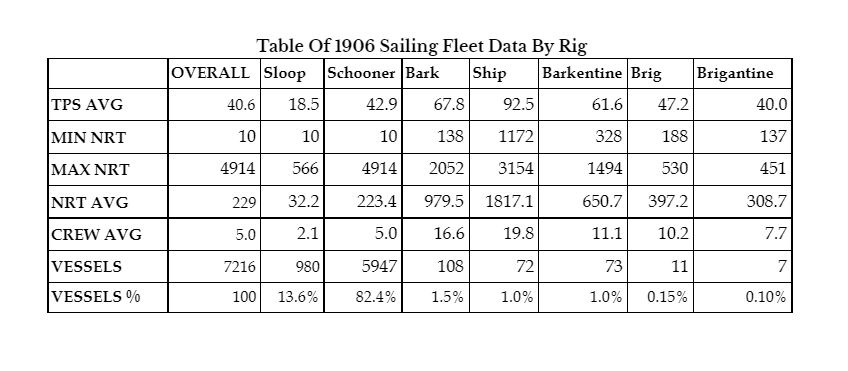
Efficiency Increases With Vessel Size.
Efficiency increases with the vessel size for all rigs, though some are only present within certain tonnage ranges, as shown in the table and figure.
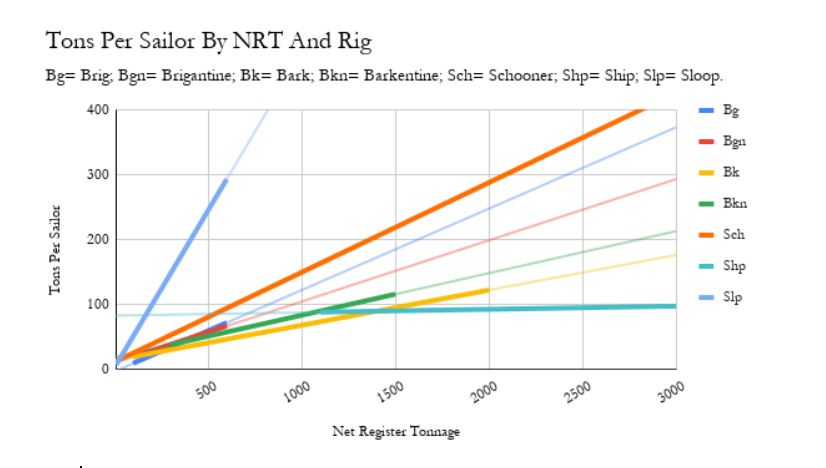
Some extrapolations can be seen in the trend-lines which extend outside the range of actual ships present in the data. For example, Schooners surpass Ships in efficiency measured in Tons Per Sailor at around 600 tons, half the capacity of the smallest ship in the sample. Further, while Schooners rapidly gain efficiency as size increases, ships are far less subject to efficiencies of scale, though Barks would be. Sloops clearly outclass all other vessels for rapidity of efficiency gains, but rarely surpass 500 tons. Ships show the least benefit from increases in scale, and in their entire tonnage range are one of the least efficient types of vessel.
To be continued…
N.B.: This blog entry was adapted from the author’s Master’s thesis. Steven Woods. “Sail Freight Revival: Methods of calculating fleet, labor, and cargo needs for supplying cities by sail.” Master’s Thesis. Prescott College, 2021. The entire thesis can be read for free here.
Steven Woods has worked in Museums and Historic Sites for over 20 years. He holds 4 college degrees, including a BA in History from the Jesuits at LeMoyne College, and a Master’s Degree in Resilient and Sustainable Communities from Prescott College. His Master’s Thesis was on supplying the New York Metro Area with food by Sail Freight.

